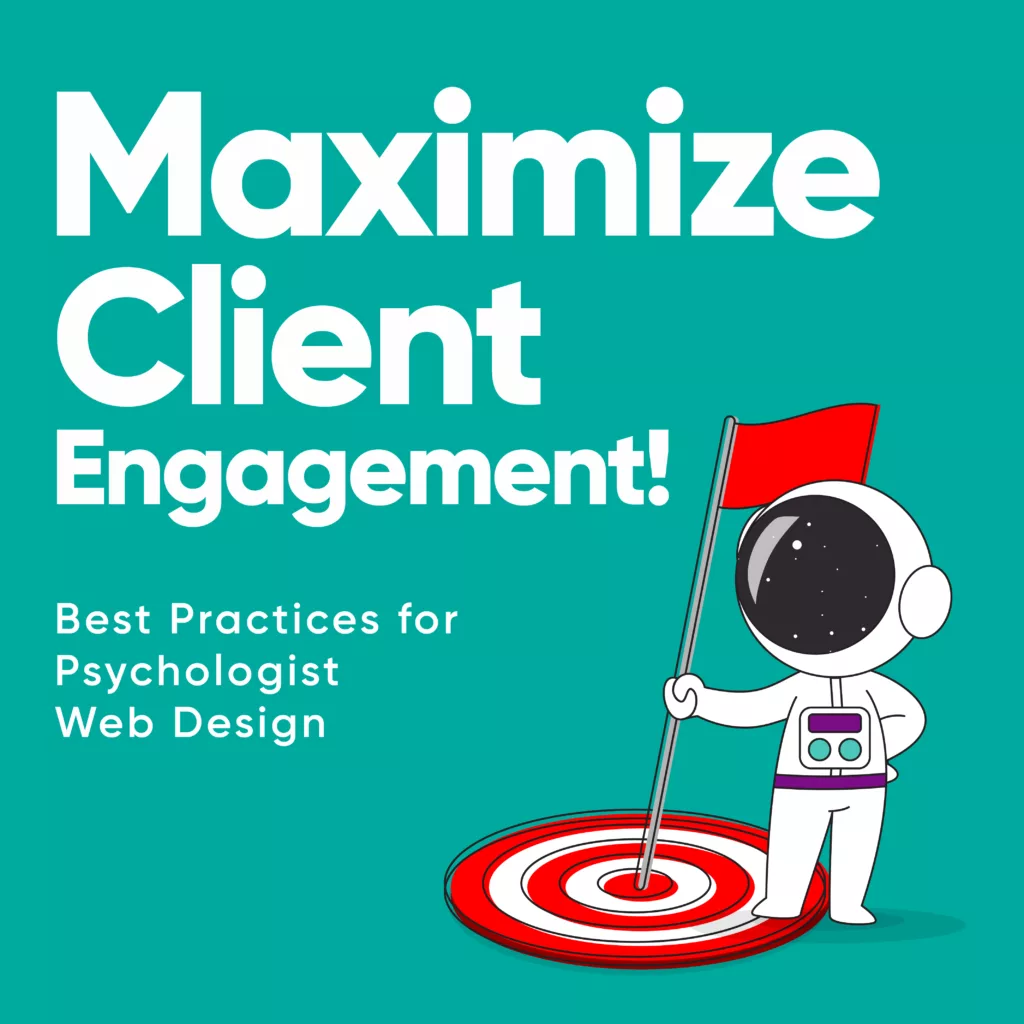Maximize Client Engagement! Best Practices for Psychologist Web Design
Professional Design For Counseling Websites
Are you a psychologist and on a quest to make a lasting mark in your profession?
Have you ever wondered how to make your psychologist web design that creates a welcoming haven to truly connects with clients?
Well, you’re in for a treat because today, we’re exploring into the world of web design with a focus on maximizing client engagement.
If you’re a seasoned psychologist or just starting your digital journey, buckle up for some web wisdom!

Initial encounters frequently occur online, that’s why possessing a website that resonates with your clients is akin to having a virtual welcome mat. Think about a scenario that a potential client lands on your site, seeking support and connection. What if your website could not just meet, but exceed their expectations?
That’s what we’re here to uncover – the psychologist website engagement best practices that go beyond aesthetics to create an experience that resonates. Why does it matter? A well-designed website not only boosts credibility but also forms a crucial link between you and your clients.
So, whether you’re a multitasking mom of four (like me!) or a tech-savvy psychologist, let’s explore the art of crafting a website that not only looks good but works wonders for your practice. Ready to jump on this web adventure? Let’s roll and start with the psychology behind effective web design. Shall we?
The Psychology Behind a Good Web Design
Let’s get a bit mind-bendy and talk about the fascinating connection between psychology and web design.
Ever stopped to think about why certain websites make you feel all warm and fuzzy inside, while others leave you clicking away faster than you can say “therapy session”?
1. The Impact of Design on Perception
First things first, your website is like the digital window into your psychologist soul. Seriously, think of it as your online office space. A cluttered, confusing space doesn’t scream “I’m here to help,” right?
We want your visitors to feel like they’ve walked into a serene and trustworthy sanctuary.
Research shows that people form snap judgments about websites. Within milliseconds, they decide whether to stay or bail. It’s like the speed-dating of the online world! So, creating a clean, purposeful design isn’t just about aesthetics; it’s about establishing trust from the get-go.
2. The Role of Empathy in Design
Now, let’s talk about a secret weapon – empathy. As psychologists, you’ve got this in your DNA.
Bring that superpower into your web design. Understand what your clients want, what resonates with them. Think of your website as a conversation starter, a virtual handshake that says, “I get you, and I’m here for you.”
Effective design is not just about what you want to convey; it’s about understanding what your potential clients need to see and feel. It’s the sweet spot where your empathy meets their expectations.
In a nutshell, psychology and web design are like the dynamic duo of the online world. They shake hands, exchange business cards, and you have a website that not only looks good but connects on a deeper level.
Ready for the nitty-gritty of psychologist web design? In the next section, we’ll explore the essential elements that transform your website into a user-friendly, trust-building wonderland.
Essential Elements of Psychologist Web Design
Now that we’ve tapped into the psyche of web design, let’s roll up our sleeves and get into the nuts and bolts – the essential elements that’ll turn your website into a user-friendly, engagement-boosting masterpiece. We’ll be exploring psychologist website engagement best practices to ensure your online presence becomes a compelling space for clients and visitors alike.
User-Friendly Navigation
Envision your website as a calming labyrinth, not a bewildering maze. Individuals in search of mental health support shouldn’t feel like they’re stepping on a confusing quest.
So, let’s talk navigation. Keep it simple, make it intuitive. Think of it as a roadmap guiding visitors to the valuable gems on your site – your services, expertise, and, of course, how to get in touch.
A clear menu structure is like the GPS for your website. Label those tabs with care, guiding your visitors seamlessly from “About Me” to “Contact” without the digital equivalent of a wrong turn.
Clean and Purposeful Design
Now, let’s declutter the virtual office space. A clean design isn’t just about aesthetics; it’s about creating a visual journey for your clients.
Less is more.
Each element should have a purpose – guiding visitors toward understanding your practice, not leaving them drowning in a sea of information. Think of your website as a room, would it be inviting or overwhelming?
Purposeful design isn’t just about what you include, it’s about what you leave out.
Mobile Responsiveness
Let’s talk about the ever-present companion in our daily lives – the smartphone. With more people browsing on mobile devices, your website needs to be the chameleon of the internet – adapting seamlessly to different screens.
Why does this matter? Because your potential clients could be checking you out while waiting for a latte or in between meetings.
A mobile-friendly design ensures they get the full experience, no matter the device. So, let’s embrace responsiveness and make your website as flexible as a yoga instructor.
We’ve laid the groundwork with user-friendly navigation, purposeful design, and mobile responsiveness. Up next, we’ll explore the magic of content – the words and stories that breathe life into your website.
Content that Connects
Importance of Compelling Content
Ever been to a website that felt like reading a dictionary? Yeah, we’re not aiming for that. Your content should be a warm embrace, not a cold lecture.
Engaging content isn’t just about what you say; it’s about how you say it. What if your ideal client, scrolling through your pages, nodding along like they’re catching up with an old friend.
That’s the magic of compelling content. It builds trust, connection, and a sense of “Hey, this psychologist gets me!
Incorporating Testimonials
Now, let’s sprinkle some social proof into the mix – client testimonials. Think of a potential client reading about others’ positive experiences with your services. It’s like a virtual pat on the back, saying, “You’re in good hands!”
Strategically place those testimonials where they can shine – maybe on your homepage or service pages. It’s like inviting your clients to share their success stories and be the VIPs of your website.
SEO Strategies for Psychologists
Now that our website is a canvas of compelling content, let’s ensure it doesn’t get lost in the vast online wilderness. It’s time to unlock the magic of SEO – your secret weapon for standing out in the digital crowd. Here are some psychologist website engagement best practices to guide you through this essential aspect of your online presence.
Keyword Integration
Keywords – the unsung heroes of online visibility. Think of them as the secret passcodes that lead potential clients straight to your digital doorstep.
But the trick is for them to flow naturally in your content, not stick out like a sore thumb. Imagine your ideal client typing into Google, seeking a psychologist just like you. What words would they use?
Those are your keywords. Sprinkle them organically in your content, like breadcrumbs, guiding them to the heart of your virtual therapy space.
Local SEO for psychologists
Now, let’s put a local spin on things. What if someone in your community searching for a psychologist nearby. That’s where local SEO steps in.
Make sure your digital signpost is visible to locals by claiming your Google My Business listing and mentioning your location throughout your site.
Why does it matter?
Because when someone nearby is looking for support, we want your website to wave from the digital horizon, saying, “I’m here for you!”
Website Analytics for Informed Decision-Making
Let’s not forget the power of website analytics.
Understanding how visitors interact with your site provides valuable insights. Track user behavior, popular pages, and the effectiveness of your content using tools like Google Analytics. This data empowers you to make informed decisions, refining your online strategy for even greater engagement.
Tips for a Psychologist Web Design That Radiates Trust
The heartbeat of your psychologist website is trust. After all, trust is the currency of connection, and your design plays a starring role in earning it. Let’s explore psychologist website engagement best practices that will not only amplify this trust but also create a digital space where visitors feel seen, heard, and understood.
Security and Privacy
Clients seeking support need assurance, especially in the digital realm. Address their concerns head-on by visibly communicating your commitment to online security. It’s like putting up a virtual “You’re Safe Here” sign, creating a sense of comfort for your visitors.
Think of it this way – just as you’d ensure a secure and confidential space in your office, your digital space should radiate the same sense of security.
Professional Imagery
A picture speaks a thousand words, right?
Well, in the online world, it could speak volumes about your professionalism and approachability. Invest in high-quality, professional images that reflect the essence of your practice.
Imagine a potential client scrolling through your website, seeing friendly faces and serene spaces. It’s like offering them a glimpse into the therapeutic atmosphere you’ve carefully crafted.
Let your images echo the warmth and professionalism you bring to your in-person sessions. In the grand symphony of trust-building, security and imagery are the keynotes.
Additional Psychologist Website Engagement Best Practices to Consider
Interactive Elements – Incorporate features like chatbots or appointment scheduling tools for immediate engagement.
Enhance the user experience by incorporating interactive elements on your psychologist website. Integrate chatbots to provide instant responses to visitor queries, creating a seamless and responsive interaction. Additionally, consider incorporating appointment scheduling tools, allowing potential clients to conveniently book sessions directly from your website.
Clear Calls to Action – Guide visitors with clear prompts, encouraging them to explore your services or get in touch.
Guide your website visitors seamlessly through their online journey by incorporating clear calls to action. Use compelling prompts that encourage exploration of your services or prompt visitors to get in touch for more information. These clear directives ensure that visitors understand the next steps and facilitate a more engaging experience.
Personalized Content – Tailor your content to resonate with your target audience, addressing their unique needs and concerns.
Create a more meaningful connection with your audience by tailoring your content to address their specific needs and concerns. Craft personalized messages that resonate with the challenges and aspirations of your target audience, fostering a sense of understanding and connection. This approach establishes trust and showcases your commitment to addressing individual needs.
Regular Updates – Keep your content fresh with regular updates, showcasing your ongoing commitment to your practice.
Demonstrate your ongoing commitment to your practice by regularly updating your website content. Fresh and relevant information not only keeps visitors engaged but also reflects your dedication to staying current in your field. Regular updates can include blog posts, news, or any developments that highlight your expertise and commitment to providing valuable information.
Accessibility Features – Ensure your website is accessible to all users, including those with disabilities, by incorporating features like alt text for images.
Make your psychologist website inclusive by incorporating accessibility features. Include alt text for images, ensuring that users with visual impairments can understand and engage with your content. By prioritizing accessibility, you create a welcoming and inclusive online environment for all visitors.
Page Loading Speed – Optimize your website for quick loading times, preventing potential clients from getting frustrated and leaving.
Prioritize a positive user experience by optimizing your website for quick loading times. Fast page loading prevents potential clients from experiencing frustration and encourages them to explore your site further. A seamless and efficient browsing experience contributes to a positive first impression and increases the likelihood of engagement.
Social Media Integration – Connect your website to your social platforms, expanding your online presence and creating a cohesive digital brand.
Expand your online presence by seamlessly integrating your website with your social media platforms. Provide links to your social profiles, encouraging visitors to connect with you on various channels. This integration creates a cohesive digital brand, allowing potential clients to engage with your content across different online platforms.
Clear Contact Information – Make it easy for visitors to reach you by prominently displaying your contact information on every page.
Facilitate direct communication by prominently displaying clear contact information on every page of your psychologist website. Ensure that visitors can easily find your contact details, including email addresses, phone numbers, and a contact form. This transparency makes it simple for potential clients to reach out and initiate contact with your practice.
Craft Websites That Inspire
And there you have it – our guide to crafting a psychologist web design that not only looks good, but fosters meaningful connections. We’ve explored the psychology behind design, the essential elements of user-friendly websites, the magic of compelling content, the SEO secrets to stand out, and the art of building trust – all integral parts of a psychologist web design contributes to the best client engagement practices.
So, why does it all matter?
Because your website isn’t just a digital space; it’s an extension of you, a virtual handshake with clients old and new. In a world where the online realm often serves as the first introduction, let’s make it count.
As you embark on this web adventure, remember that simplicity is powerful, empathy is your superpower, and trust is the bridge that connects hearts and screens. Your website isn’t just pixels and code; it’s a canvas for your therapeutic journey to unfold.
Ready to take the next step towards a more engaging and impactful online presence?
Now, it’s over to you. Take these insights, infuse them with your unique essence, and let your website become a beacon of hope, understanding, and connection.
Ready to take the next step towards a more engaging and impactful online presence? Schedule your free 30-minute call with me today. Let’s discuss how we can elevate your psychologist website to connect more effectively with your audience.
As we wrap up, know that your impact reaches beyond the office walls and into the digital spaces where lives are touched and stories unfold. Here’s to creating websites that not only engage, but inspire.
Related Reads for Starting A Therapist Website
- Best Ecommerce Solutions for Small Business and Therapy Practice Websites
- Custom vs template website For Your Therapy Practice
- Tips on Website Design For Mental Health Professionals
- Advanced Features for Psychiatry Practice Websites
- The Benefits and Drawbacks of a Counseling Website Template: A Comprehensive Guide
- Web Design for Therapists and Healers
- 4 Ways to Identify Web Design Goals for Your Therapists Website
- Web Design for Psychologists
- Benefits of Getting Customized Therapy Website Builder Services
- Website For Forensic Psychology Practice
- Best Practices for Psychologist Web Design
- Building a Therapist Website That Works
- Customized Websites for Child Therapists
- User-Friendly Website Templates For Therapists
- Photos for Your Therapy Website | Counseling Stock Photos
- 4 Factors to Consider When Choosing the Best Mental Health Website Design
- Private Practice Therapist Websites: Secrets to Success
- Therapist Websites: 8 Myths Every Therapist Should Know!
- Affordable Website Development for Counseling Professionals
Need any of the following? Contact us!
Here are some Sample Websites We’ve Created:
Check out our Portfolio for more!
Hi! I’m Sarah.
I help counselors and therapists have a bigger impact on the world through better client connection. I do this by creating beautiful visuals and strategically designed websites.


